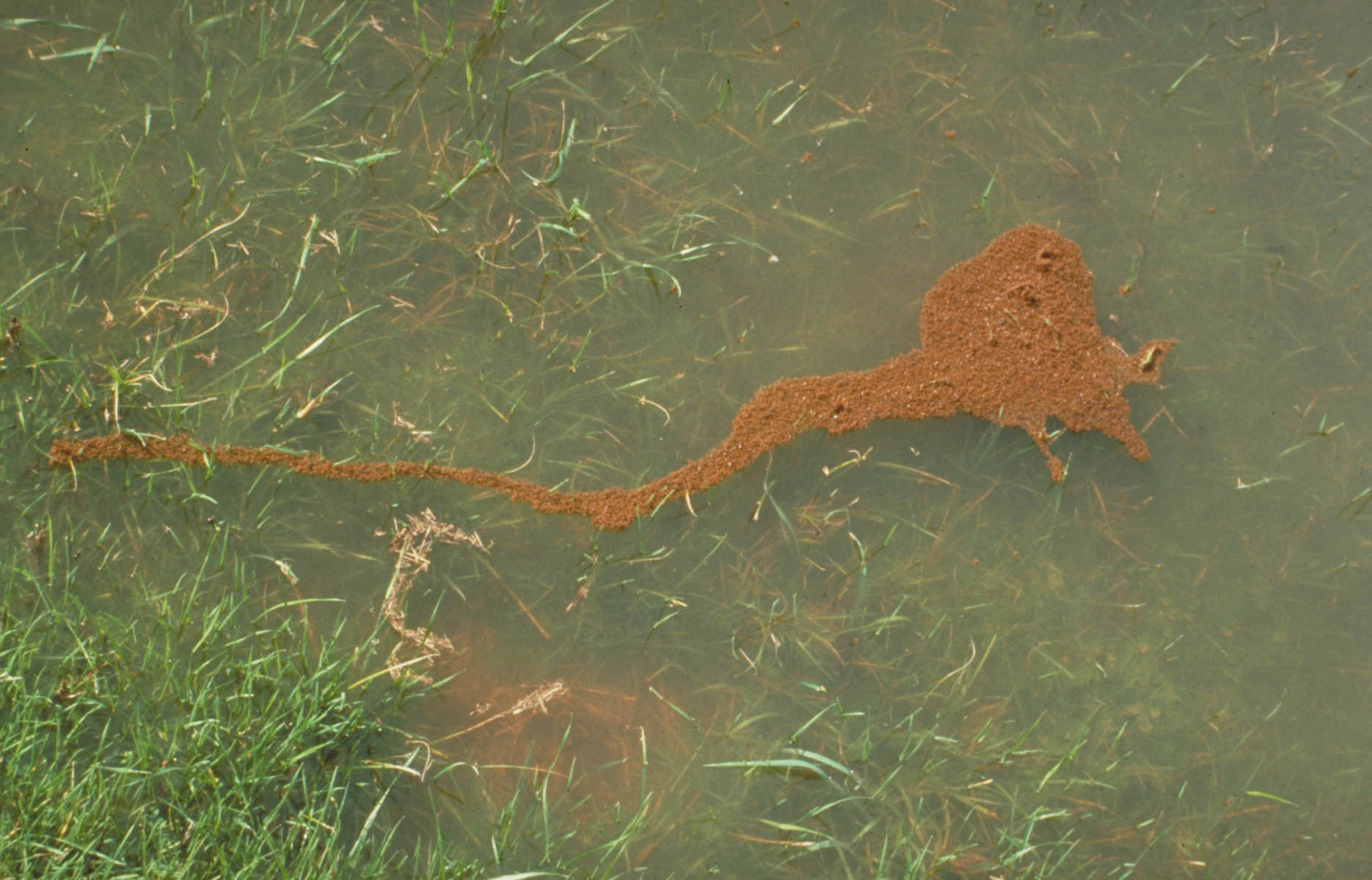Emergency Handbook

Tremendous amounts of rain can fall over a short period of time, resulting in flooding of low-lying areas. With this flooding comes the problem of various insects trying to find safe, dry ground. In areas of the South infested with red imported fire ants, these ants and their colonies can present a potentially serious medical threat to people and animals during times of flooding.
Floodwaters will not kill fire ants. Instead, their colonies will actually emerge from the soil, form a loose ball, float, and flow with the water until they reach a dry area or object that they can crawl up on. Floating fire ant colonies can look like ribbons, streamers, or a ball of ants floating on the water. These amoeba-like masses of ants contain all of the colonies’ members—the worker ants, brood (eggs, larvae, pupae), winged reproductive males and females, and queen ants.
As the floodwaters recede, these floating fire ant colonies will get on anything they come in contact with. They are attracted to anything that might give them shelter until a mound can be reestablished in the soil. This means that debris piles left from the floodwaters or piles of items from flooded homes are extremely inviting to fire ants. Ant colonies or ants encountered have to be dealt with quickly.
During Flooding
- Avoid contact with floating mats of fire ants.
- If you are in a rowboat, do not touch the ants with the oars.
- When working in floodwater, try to dress appropriately. Rubber boots, rain gear, and gloves (cuffed) can help prevent ants from reaching the skin.
- If ants contact the skin, they will sting. They should be removed immediately by rubbing them off. The ants will only cling to the skin if submerged. Even a high-pressure water spray may not dislodge them. However, a spray made of diluted, biodegradable dishwashing liquid may help immobilize and drown them.
- When returning to flooded structures, floating ant masses are occasionally encountered, even indoors.
After Flooding
Be aware that fire ants can be under anything. When debris is picked up, pay attention to what is on, under, or in it—especially if the debris has been sitting in one area for several days. Fire ants will get under furniture, carpet strips, and old wood to reestablish their colony.
Protect yourself. Wear gloves, long-sleeved shirts, long pants, socks, and shoes. Consider spraying insect repellent (e.g., products containing DEET) onto your shoes and lower pants legs. This may help deter foraging fire ants from climbing onto the legs, but may not repel ants defending their colony.
If using shovels or other tools, spread talcum or baby powder on the handle. Fire ants cannot climb onto vertical surfaces dusted with talcum powder unless the surface gets wet or the powder is rubbed off.
If fire ants are seen in a pile of debris that must be handled, use a shovel or other tool to avoid ant contact or consider treating the pile with fast-acting household or lawn and garden insecticide. Aerosol spray products containing pyrethrins or pyrethrum derivatives (tetramethrin or allenthrin), which are labeled for use on ants or crawling insects, have a quick knockdown, and they break down quickly.
Spray as many of the ants as possible. But keep in mind that insecticides can be quite toxic to aquatic organisms. Also spray surfaces and cracks of infested objects and debris. Come back after the product has had time to act. Fire ant bait products should not be used at this time. They are slow-acting. The flooded mounds will be disorganized, and worker ants will not be foraging for food.
How to Treat Fire Ant Stings
Fire ant stings can be treated using over-the-counter medicines for insect bites or stings. To relieve the irritation from a fire ant sting, use a sting-relief medication or remedy within the first 15 to 20 minutes.
An antibiotic cream can be used to help prevent secondary infections. Many people may be allergic to fire ant venom. Reports of sting victims going into anaphylactic shock are not uncommon. Shortness of breath, unusual swelling of the sting area, or nausea are symptoms that should prompt immediate medical attention.
Used by permission of eXtension.org.
Image courtesy of Dr. Bart Drees, Texas AgriLife Extension
Use pesticides only according to the directions on the label. Follow all directions, precautions, and restrictions that are listed. Do not use pesticides on plants that are not listed on the label. Trade and brand names used are given for information purposes only. No guarantee, endorsement, or discrimination among comparable products is intended or implied by the Alabama Cooperative Extension System. This publication is for information purposes only and should not be a substitute for recommendations or treatment by a health care provider.

